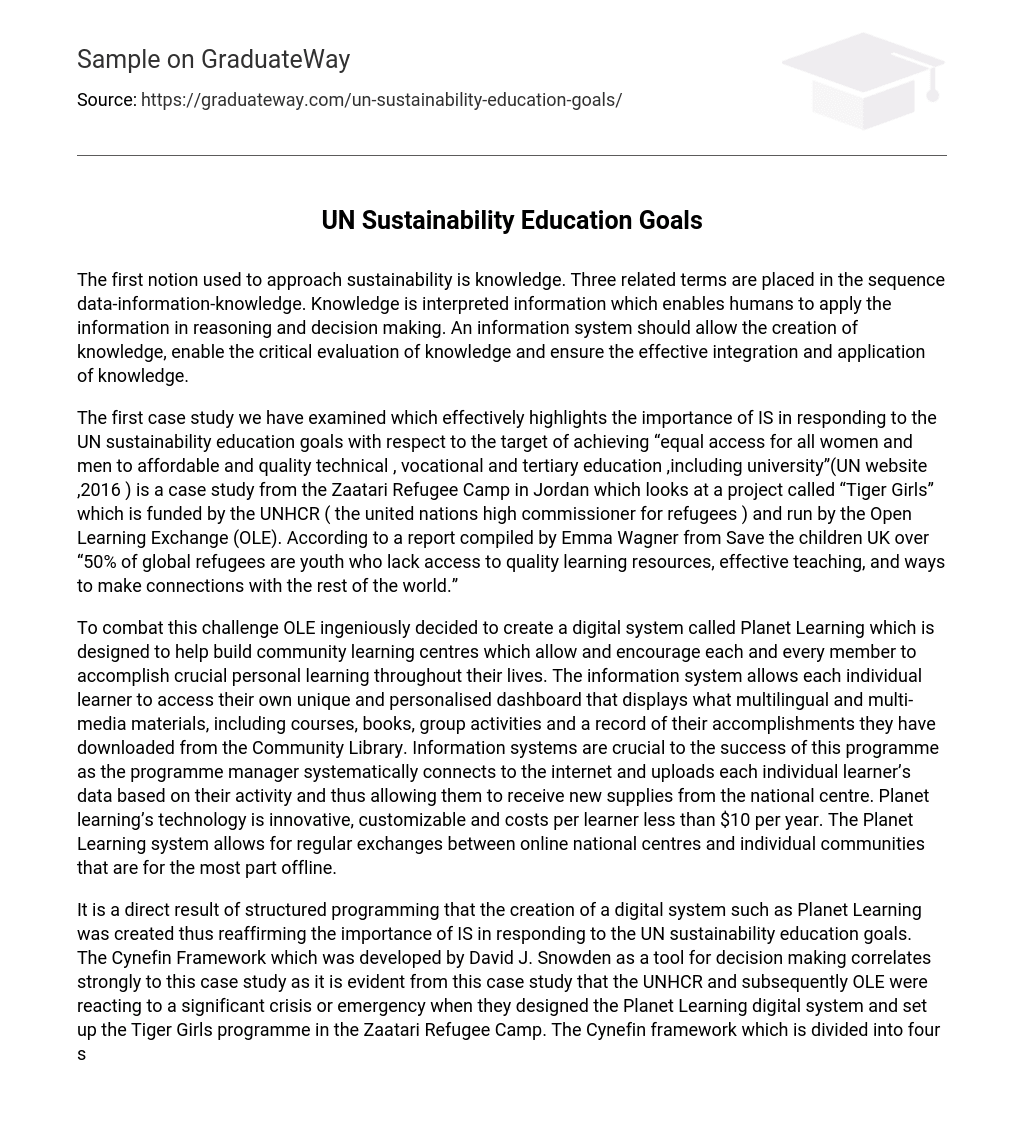The first notion used to approach sustainability is knowledge. Three related terms are placed in the sequence data-information-knowledge. Knowledge is interpreted information which enables humans to apply the information in reasoning and decision making. An information system should allow the creation of knowledge, enable the critical evaluation of knowledge and ensure the effective integration and application of knowledge.
The first case study we have examined which effectively highlights the importance of IS in responding to the UN sustainability education goals with respect to the target of achieving “equal access for all women and men to affordable and quality technical , vocational and tertiary education ,including university”(UN website ,2016 ) is a case study from the Zaatari Refugee Camp in Jordan which looks at a project called “Tiger Girls” which is funded by the UNHCR ( the united nations high commissioner for refugees ) and run by the Open Learning Exchange (OLE). According to a report compiled by Emma Wagner from Save the children UK over “50% of global refugees are youth who lack access to quality learning resources, effective teaching, and ways to make connections with the rest of the world.”
To combat this challenge OLE ingeniously decided to create a digital system called Planet Learning which is designed to help build community learning centres which allow and encourage each and every member to accomplish crucial personal learning throughout their lives. The information system allows each individual learner to access their own unique and personalised dashboard that displays what multilingual and multi-media materials, including courses, books, group activities and a record of their accomplishments they have downloaded from the Community Library. Information systems are crucial to the success of this programme as the programme manager systematically connects to the internet and uploads each individual learner’s data based on their activity and thus allowing them to receive new supplies from the national centre. Planet learning’s technology is innovative, customizable and costs per learner less than $10 per year. The Planet Learning system allows for regular exchanges between online national centres and individual communities that are for the most part offline.
It is a direct result of structured programming that the creation of a digital system such as Planet Learning was created thus reaffirming the importance of IS in responding to the UN sustainability education goals. The Cynefin Framework which was developed by David J. Snowden as a tool for decision making correlates strongly to this case study as it is evident from this case study that the UNHCR and subsequently OLE were reacting to a significant crisis or emergency when they designed the Planet Learning digital system and set up the Tiger Girls programme in the Zaatari Refugee Camp. The Cynefin framework which is divided into four segments named complex, complicated, simple and chaos helps people to make better decisions in crisis’s and emergencies and inform them of how to act accordingly, which is undoubtedly evident in the case study we have examined above.
With regards to recommendations which could help advance the target further and thus achieve the overall goal of quality education, we recommend that OLE’S digital system Planet Learning should be rolled out on a larger scale to more countries with support and funding from local and national governments and agencies which it currently does not have. We also recognise that there is huge potential for OLE’s digital system Planet Learning to be used to connect children and youths of similar backgrounds and those that have also experienced crises to connect with one another and to promote the importance of education as a pathway of bettering their lives.
In an aim to create a sustainable solution to this educational target the current crisis must be approached with a long-term perspective, therefore we recommend that future collaborations be improved and long-term sustainable partnerships be developed and that inclusive national systems be strengthened in order to achieve sustainability. In 2016 the education sector received only 2.7% of humanitarian funding as evident from a recent policy paper published by the Global Education Monitoring Report. The vast majority of refugee education interventions rely heavily on funding from the severely underfunded humanitarian system which does not use multi-year funding but instead uses annual funding arrangements making it extremely hard to achieve long term funding and subsequently achieve sustainability.





